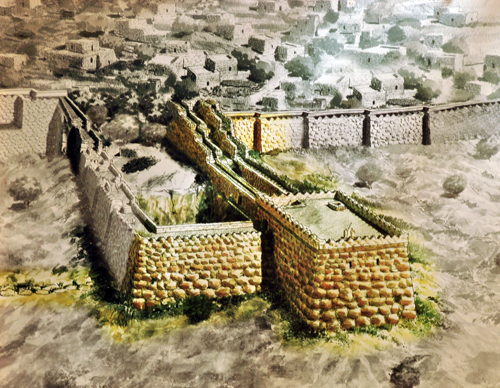During a visit to the City of David last week, I noticed that the Pool next to the Gihon Spring is being opened up for viewing. Scaffolding has been put inside the pool, apparently in preparation for the casting of a permanent concrete ceiling. The rocky southern edge of the pool is clearly visible, but there no remains of any wall built on that side could be detected.

In the initial reports it was claimed that a tower surrounded this pool. A reconstruction drawing on the site shows the Pool Tower to the left of the Spring Tower, a defensive tower built over the Gihon Spring. Both towers were accessed via a fortified passageway:

Although we have to wait for an official report, it appears that the pool was open on all sides, apart from the protective passage giving access to the waters of the pool at its northwest corner. The unprotected pool therefore must have been located inside the city walls. A larger area than was thought previously must have been added to the east of the original city.

I’m a bit confused now, Mr. Ritmeyer. In your review of a book by Ronny Reich in May 2011, you wrote “Two massive walls created a safe approach to a Rock-cut Pool from which water could be drawn.” Was this a reference to the other pool? Or did new research overturn that view?
Apart from that, just one idea: It looks like rather early in the history of Jerusalem, the availability of water was guaranteed by the aquaeducts and the huge lot of cisterns. According to Warren/Wilson’s “Recovery”, the temple mount’s facilities alone stored 10 million gallons of water. And afaik (from what I read so far) the city never experienced a scarcity of water during a siege. So, can it be that the Gihon spring simply wasn’t essential for the citizens, and that that water was mostly used for the ritual mikveh baths, for which the pool with its steps was very convenient?
And excuse me pls for the relatively high number of comments I post here. Be assured it’s because of genuine interest, but I know I sometime get carried away a bit in my enthusiasm. I do hope that’s not a nuissance for you.
Hey there! I’ve been following your weblog for some time now and
finally got the courage to go ahead and give you a shout out from Kingwood Texas!
Just wanted to mention keep up the excellent job!
I blog frequently and I truly appreciate your information. Your article has really peaked my interest.
I’m going to bookmark your website and keep checking for new details about
once a week. I opted in for your RSS feed as well.
My blog … blog post immediately